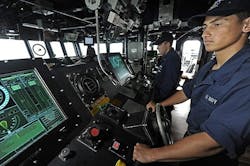Northrop Grumman Sperry Marine to provide shipboard bridge navigation for Burke-class destroyers
WASHINGTON – U.S. Navy shipboard electronics experts needed bridge navigation systems for new-build Arleigh Burke-class (DDG 51) guided missile destroyers, as well as for upgrades on existing Burke-class destroyers. They found their solution from the Northrop Grumman Sperry Marine B.V. in Charlottesville, Va.
Officials of the Naval Sea Systems Command in Washington announced an $18.2 million contract to Northrop Grumman Sperry Marine on Wednesday to provide common integrated bridge and navigation systems (IBNS) for Burke-class destroyers.
These integrated bridge and navigation systems are part of the DDG-51 destroyers New Construction Ship program and DDG-51 Midlife Modernization program, Navy officials say.
The IBNS is a hull, mechanical, and electrical upgrade to modernize Burke-class destroyers to ensure the ships remain combat relevant and affordable throughout their life cycles, Navy officials say, adding that this contract will serve as the base hardware production contract for IBNS systems.
Sperry Marine military integrated bridge systems handle automated collection, processing, control, and display of ship control and navigation sensor data to help make the most of bridge watch efficiency and ship control safety.
These systems blend voyage planning and real-time bridge navigation tracking; track steering ship control; radar contact track and video overlay; interfaces to the machinery control systems; moving haven and water space management; position uncertainty fix expansion; lines of position navigation fix capability; commanding officer password protect of approved voyage plans; electronic bearing lines and variable range; chart markup; operator text overlay; operating areas; over-the-horizon areas of uncertainty; joint tactical action areas; and submarine-generated search areas.
Integrated bridge system components include the Voyage Management System (VMS), a computer based navigation, planning, and monitoring system. It meets U.S. Navy’s Electronic Chart Display and Information System - Navy (ECDIS-N) requirements, and provides tools for the ship's crew to navigate electronically.
Also part of the IBS is the Automated Radar Plotting Aid (ARPA) system that automatically acquires and tracks contacts for the ship's bridge watch team.
Related: Shipboard electronic systems pursue open architectures
The IBS also has the Ship Control System (SCS) that provides command and control signals to the ship control and propulsion systems and monitors their performance.
Sperry Marine military integrated bridge systems are fielded aboard U.S. Navy aircraft carriers, cruisers, destroyers, amphibious assault ships, submarines, and landing craft, as well as aboard NOAA ships, Coast Guard ice breakers, and international naval vessels.
On this contract Northrop Grumman Sperry Marine will do the work in Charlottesville, Va., and should be finished by February 2020. For more information contact Northrop Grumman Sperry Marine online at www.sperrymarine.com, or Naval Sea Systems Command at www.navsea.navy.mil.
Ready to make a purchase? Search the Military & Aerospace Electronics Buyer's Guide for companies, new products, press releases, and videos

